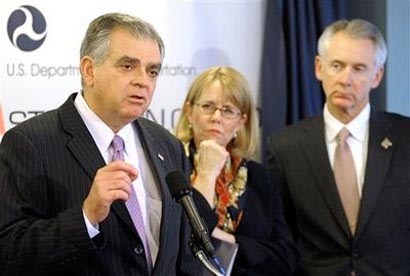 Like drunk driving and wearing a seat belt, avoiding distracted driving is becoming more and more of a no brainer. The Department of Transportation has reported that there were 6,000 deaths and half a million injuries caused by distracted driving last year alone, making it the number one killer of teenagers. But as technology becomes more advanced, the temptation to text, email, or talk on the phone while driving becomes even more of a problem. In a major story for its April edition, Consumer Reports has targeted distracted driving, its major opponents, and listed ideas for what regular people can do to end it.
Like drunk driving and wearing a seat belt, avoiding distracted driving is becoming more and more of a no brainer. The Department of Transportation has reported that there were 6,000 deaths and half a million injuries caused by distracted driving last year alone, making it the number one killer of teenagers. But as technology becomes more advanced, the temptation to text, email, or talk on the phone while driving becomes even more of a problem. In a major story for its April edition, Consumer Reports has targeted distracted driving, its major opponents, and listed ideas for what regular people can do to end it.
To date, 30 states including the District of Colombia have adopted laws against distracted driving. But many members of congress have been weary of a federal distracted driving law, fearing that it would interfere with states rights. In an interview with Consumer Reports, Transportation Secretary Ray LaHood says that’s going to change, if he has anything to do with it. “We’re going to push Congress to pass a federal law,” said LaHood, a tireless advocate for stricter distracted driving laws. “We believe a federal law with good enforcement can change people’s behavior.” LaHood also said that police officers should be able to pull a driver over for talking on his or her phone; currently, drivers can only be cited for distracted driving as a secondary offense.
LaHood has long said that laws are ineffective if they’re not backed up with strict enforcement. To test this theory, the Department of Transportation launched extensive enforcement programs in Syracuse, New York and Hartford, Connecticut. Halfway through the program, handheld cell phone use was down 56 percent in Hartford, and 38 percent in Syracuse. “We know there is a dramatic change in behavior when somebody gets a ticket, when a law is enforced,” said LaHood of the program.
The Consumer Reports survey supports LaHood’s contention that distracted driving laws aren’t being enforced strongly enough to impact driver behavior. Of the 78 percent of respondents who told Consumer Reports that they have stopped distractions, 66 percent said the behavior change was due to reading about the dangers of distracted driving, and 44 percent said they were deterred by laws against the practice, but only 1 percent said they were issued a ticket for distracted driving. This is quite low, considering that 80 percent of respondents admitted to habitually texting or talking on the phone behind the wheel in the past.
Fortunately, safety advocates, phone companies, and technology manufacturers are taking clear steps to help teenagers and adults end distracted driving. We’ve compiled a list of some of the best tech devices for distracted drivers, as has Consumer Reports. These include hands free aids, in addition to phone blockers that take away the urge to text altogether.
There are other actions concerned drivers can take to help end distracted driving. Support state and national laws against distracted driving, for example, and the push to make distractions a primary, rather than secondary, driving offense. The nonprofit organization that backs Consumer Reports suggests a four pronged approach to distracted driving that includes collecting more data, implementing more and stronger laws, boosting enforcement, and simplifying vehicle and cell phone controls.
There are also more grassroots groups taking up the fight against distracted driving. Even teens, who are generally considered the worst offenders, have launched organizations – like Students Against Destructive Decisions – to make a stronger peer-to-peer connection. And, of course, distracted driving can be combated on Facebook and Twitter, by following streams like @iDriveSafeUSA, @DontTwive, @DropItAndDrive, and @RayLaHood.

